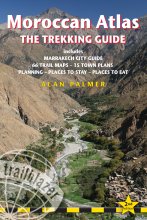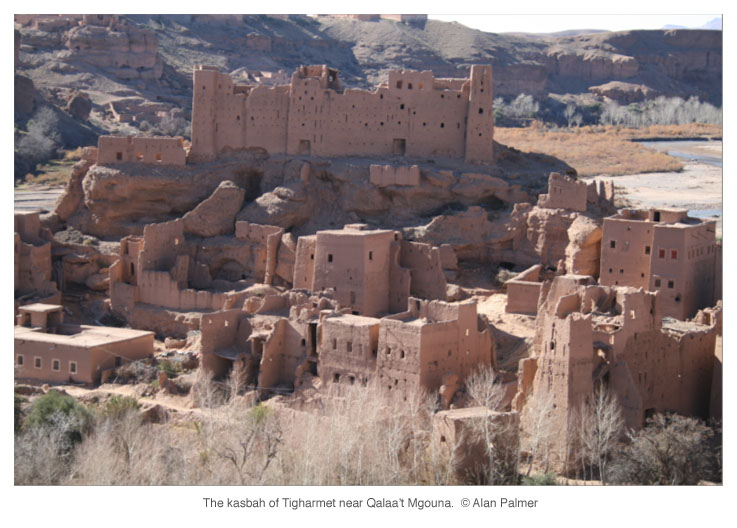'Fantastically detailed and well-presented.'
— Backpack magazine

Moroccan Atlas - the Trekking Guide
Excerpt:
Introduction
Contents | Introduction | Minimum impact trekking | Planning your trip | Marrakech | Using this guide | Sample trek: Toubkal circular trek | Moroccan Atlas Trekking Routes
Morocco – ‘le pays lointain le plus proche’
Morocco is a fascinating world of extremes. There are few places on earth where you can journey with such ease from the comfort of exotic cities,  only ever imagined in an Arabian Nights fantasy, into a remote wilderness with extraordinary contrasts of stark mountains, green valleys and harsh deserts, of colourful, hospitable peoples and isolated, picturesque settlements.
only ever imagined in an Arabian Nights fantasy, into a remote wilderness with extraordinary contrasts of stark mountains, green valleys and harsh deserts, of colourful, hospitable peoples and isolated, picturesque settlements.
The Moroccan Atlas is a mountain range of exceptional beauty and cultural interest but it is still relatively little visited, a fact which makes the Atlas, to my mind, a far more exciting proposition than the European ranges. Add to that the wonderful hospitality of the local Berber people, the rich texture of North African life and the dazzling allure of Marrakech and other Moroccan centres, and you will begin to see why a growing number of trekkers are choosing to explore this great range which the ancient Greeks thought to be the home of Atlas.
Why Morocco? On the one hand, it can be quickly and easily reached by most Western travellers; yet, on the other, Morocco calls us to step into a fantastic, often surreal world that, in so many aspects, is so very, very far from our own. As was once explained to me long ago, Morocco surpasses all other destinations because it is quite simply ‘le pays lointain le plus proche’ (the nearest far away country).
About this book
This guidebook has been written with both the experienced and novice trekker in mind. The routes described are challenging but accessible. Regular hikers might find they cover ground more quickly than the route notes suggest but the book has been designed to allow readers to tackle as much or as little as they please at any one time. In this second edition, the classic route descriptions of the first edition have been updated and links between them have been added, providing trekkers with greater choice and flexibility both in the route that they choose to follow and in the number of days that they spend on the trail.
The routes
This book can include only a fraction of the treks available in the Atlas Mountains which span some 1500 miles across Morocco, Algeria and Tunisia. Yet the routes detailed here form an excellent representative selection and each offers some distinct or unique draw which qualifies it for inclusion in the guide: the Western High Atlas is probably the greenest region and the least touched by modern progress; the Toubkal area is the highest in North Africa; Mgoun is arguably the most classically beautiful; Sirwa is remote and challenging; while the semi-desert of Sarhro reveals the Atlas at its most unusual and striking best. This book also contains detailed information on Marrakech, an exploration of which is a fascinating part of the Atlas experience, and Ouarzazate, the ‘gateway to the desert’, as well as all other relevant towns and trailheads. Practical information on every aspect of planning, arranging and enjoying an Atlas trek is included – from what to pack to what to say in French, Arabic and Berber. There is also a section on the fauna of the Atlas, a guide to bird-life and a chapter on minimum impact trekking.
Why trek?
Here’s an early experience, shared with Lynda in the Central High Atlas Mountains when, travelling blind, having first blundered naively into danger we were transported deep into the heart of Berber hospitality. This chance encounter helped to open up to us the enchanted world to which we continue to feel compelled to return.
Perhaps he emerged from out of the ground. Perhaps he was a boulder gifted the breath of life or perhaps he was a trick of the light.
As we stood on the crest of a barren hillside and stared into the darkening gloom now enveloping the mountains, our hopes of finding a resting place for the night were fading. It was then that he moved. He must have heard us for a mile or so before he saw us, for no other life stirred that night. So unlikely was life amongst those fields of dust that at first I believed my eyes were being fooled. Not a word was spoken between us but we immediately felt his warmth and he our need. Without a moment’s hesitation, he led and we followed.
Only the sense of the ground falling beneath our feet and the occasional ink blue glimmer of Bou Guemez below told us that we were descending. We continued to place our trust in the hands of this stranger and to follow him along ever-narrowing pathways, rather like following the boughs, then branches, then twigs of the indigenous argan tree, into the valley below until, quite without warning, he turned into a courtyard. Only moments before there had been no houses. Yet, rather as had our guardian, just at that point when we had begun to wonder whether fortune had deserted us, houses leaped up, not one or two, but a whole village of sun-baked bricks, out of the blackness of the night.
The glow of a paraffin lamp within drew us like moths to an almost bare room. Boots flicked to one side at the threshold, we were seated cross-legged on the floor around a silver teapot and a copper kettle which, through their very simplicity, assumed magical proportions.
Muffled tones of female voices could be heard from somewhere along unlit passages leading to further recesses within the house, voices which sometimes unexpectedly rose into animated exchanges, yet still we waited, uncertain as to what would unfold, whether we would be permitted to meet them, even in the half-light of the burner. They were active, and we sensed that our arrival had stirred that activity. But though we sometimes glimpsed shadows and silhouetted female forms, no woman came to our room.
When the door finally reopened, a young man entered bearing yet-unripe walnuts and fresh mint tea. They were spread before us across the geometric patterns of deep red hand-knotted rugs. Only when our host was assured that we were satisfied did he withdraw to leave us to our privacy, privacy in this, the prime room of his house, which now, without thought for his family or himself, he gave over to us.
Later that night we looked into each other’s eyes and smiled, each mirroring peace and happiness to the other. We had forgotten all about the darkness which had by now quite engulfed the barren hillside outside. And we, though cocooned in our sleeping bags, felt so elated it seemed we were flying. © Alan Palmer
Latest tweets